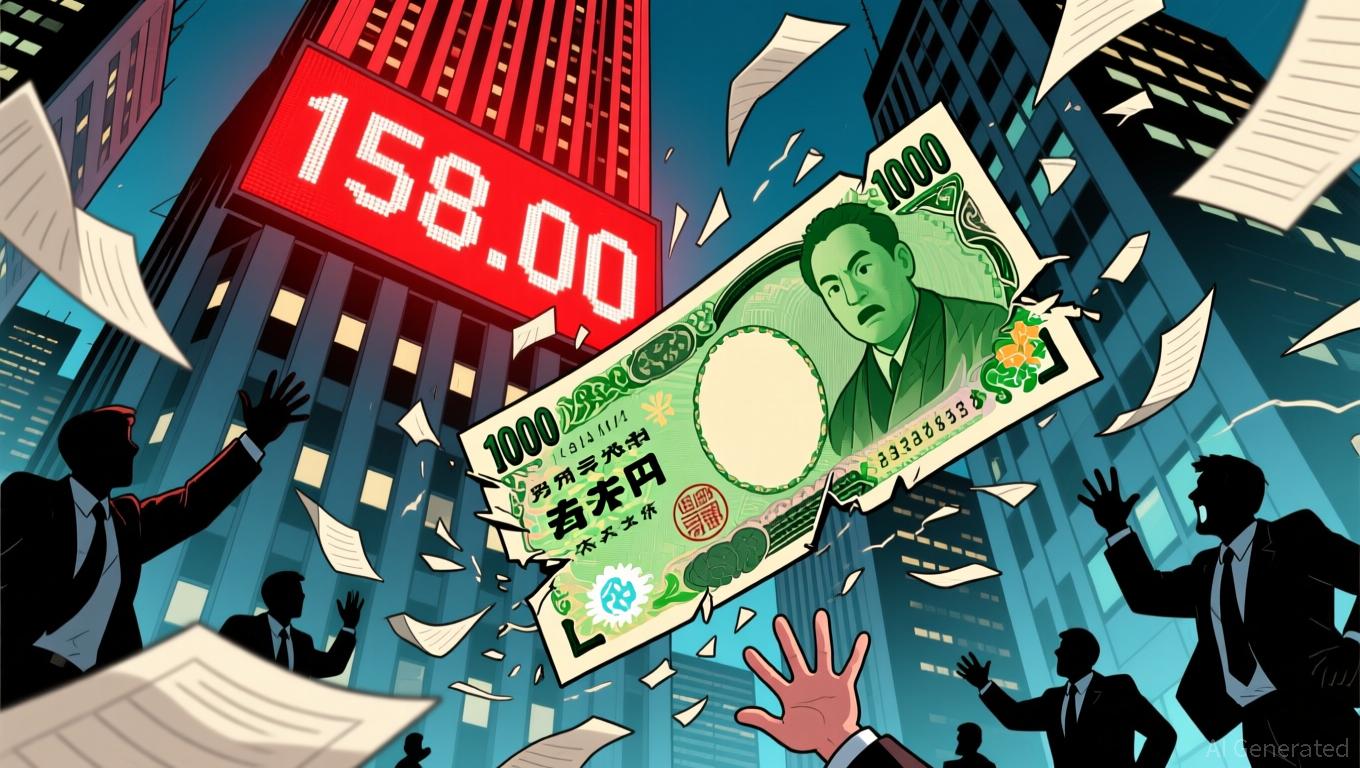Policy Showdown: Yen’s Decline Challenges Japan’s Economic Unity
- Japan's yen plunges to 10-month lows as dovish BoJ policies and fiscal stimulus clash with U.S. rate differentials. - Governor Ueda emphasizes data-driven decisions while Finance Minister Katayama warns of "disorderly" market intervention risks. - 21.3-trillion-yen stimulus package raises inflation to 3.0%, deepening policy tensions between fiscal expansion and monetary restraint. - Fed's delayed rate cuts and geopolitical factors like China's tourism decline compound yen's vulnerability to speculative s
The Japanese yen has dropped to precarious lows, fueling intense speculation over whether the Bank of Japan (BoJ) or the Ministry of Finance will step in to halt its slide. As the USD/JPY pair challenges the 158.00 resistance, dovish policy stances and persistent inflation have intensified
BoJ Governor Kazuo Ueda has reiterated that policy moves will

The government’s aggressive fiscal stance has come under the microscope,
The yen’s rapid fall has led Japanese authorities to issue verbal warnings. Katayama made it clear that
Traders are watching closely for any signs of official intervention,
The U.S. dollar’s resilience, supported by fading hopes for Federal Reserve rate cuts, has added to the yen’s troubles.
At the same time, geopolitical strains—such as China’s reduction in tourism to Japan after Takaichi’s remarks on Taiwan—have further weighed on the yen by reducing export demand. These developments highlight the complex relationship between domestic policy decisions and external shocks, making the BoJ’s pursuit of stable inflation and currency values even more challenging.
With USD/JPY nearing key technical thresholds, the BoJ and Japanese government are facing a crucial test of their ability to coordinate policy. While verbal interventions have offered short-term relief, lasting stability for the yen may require decisive steps—whether through rate increases, fiscal adjustments, or direct market action. Investors remain cautious, as the outcome will likely influence not only Japan’s economic direction but also the broader global currency landscape.
Disclaimer: The content of this article solely reflects the author's opinion and does not represent the platform in any capacity. This article is not intended to serve as a reference for making investment decisions.
You may also like
Cardano News Update: Midnight Achieves 24 Billion Token Milestone at 0.80 ADA, Driven by Cardano's Minimal Fees
- Midnight's Cardano-based privacy sidechain minted 24B NIGHT tokens at 0.80 ADA ($0.52), showcasing Cardano's low fees and scalability ahead of Dec 8, 2025 launch. - The project uses ZK-SNARKs for privacy-compliant transactions and a dual-token model (NIGHT for governance, DUST for shielded payments) with cross-chain synchronization. - Token distribution will occur in phases over 360 days, with initial allocations to early contributors and planned exchange listings to stabilize market dynamics. - Cardano'

ZKP's Code-Driven Fairness Transforms Cryptocurrency Auctions
- Zero Knowledge Proof (ZKP) launches a transparent, fair, anti-whale ICA model using real-time demand and on-chain data for token distribution. - Daily 24-hour auctions allocate 200M tokens via dynamic pricing, with contributions in ETH/USDC/ZUSD determining final prices through algorithmic calculations. - Smart contracts enforce $50,000 per-wallet caps to prevent market manipulation, ensuring equal access through code-enforced fairness. - Pre-built infrastructure including hardware/software and a decentr

Bitcoin’s Sharp Decline: Caution Sign or Chance to Invest?
- Bitcoin's $87,000 drop reflects macroeconomic pressures from Fed policy shifts and $2.7T U.S. stock market losses, with Ray Dalio questioning its reserve asset utility. - The Bitcoin for America Act enables tax payments in BTC, creating a 4. 3M coin Strategic Reserve potentially worth $14T at $3.25M/coin, signaling institutional confidence. - Global regulators (MiCA, FIMA Act) reduce crypto ambiguity while Bernstein sees $80,000 as a potential buying zone amid ETF inflows and Trump-era policy tailwinds.
The Factors That Led to Bitcoin’s Sharp Decline at the End of 2025
- Bitcoin's late-2025 crash stemmed from Fed rate hikes, regulatory ambiguity, and institutional risk aversion despite adoption growth. - The Fed's hawkish stance reduced liquidity, pushing investors toward fixed-income assets while SEC's inconsistent enforcement deepened uncertainty. - Institutional Bitcoin holdings (3.5% circulating supply) couldn't offset sell-offs as macroeconomic pressures and legal vacuums triggered hedging strategies. - Market participants now prioritize rate-hedging tools, regulato